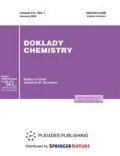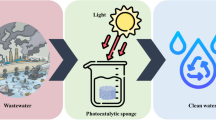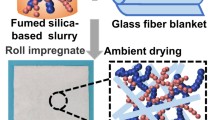Abstract
A composite of alumina nanofibers (ANF) and modified detonation nanodiamonds (MDND) was produced by mixing aqueous suspensions of the components in a weight ratio of 5 : 1 with subsequent incubation of the mixture for 15 min at 32°C. It was assumed that the formation of the composite is ensured by the difference of the zeta potentials of the components, which is negative for MDND and positive for ANF. Vacuum filtration of the mixture through a fluoroplastic filter (pore diameter 0.6 μm) formed disks 40 mm in diameter, which were then heat-treated at 300°C to impart structural stability to the composite. Scanning electron microscopy detected that the obtained composite has a network structure, in which MDND particles are distributed over the surface of ANF. It was determined that the MDND particles incorporated in the composite catalyze the phenol–4-aminoantipyrine–H2O2 oxidative azo coupling reaction to form a colored product (quinoneimine). The applicability of the composite to repeated phenol detection in aqueous samples was demonstrated.
Similar content being viewed by others
One of the fields of scientific research that has actively been developed in the world in the last decade is to explore the applicability of nanomaterials of various physicochemical nature to developing new efficient means of biomedical analysis [1–6]. A promising material for these purposes is modified detonation nanodiamonds (MDND), which have colloidal stability in dispersion media [7]. The chemically polymorphic surface of MDND (the presence of a wide range of chemically active groups and trace impurities of metals [8]) and the possibility of its chemical modification make it possible to use these nanoparticles in creating biomedical-purpose analytical systems. It was demonstrated that MDND can be used as a catalyst and a carrier of biomarkers (enzymes) in designing multiple-use indicator and diagnostic test systems for medical and ecological analysis [9, 10]. In particular, in vitro studies showed the efficiency of MDND for repeated phenol detection in aqueous samples [10].
MDND-based analytical systems in which a sensing element (MDND or MDND–biomarker(s)) is immobilized on/in a solid matrix are practically more preferable. The structural stability of the matrix opens up possibilities for creating indication systems as strong 2D- and 3D structures (plates, disks, rods, etc.), which are more convenient for testing samples and simplify procedures of washing the system in its multiple use. As a matrix for immobilizing MDND, alumina nanofibers (ANF) can be of interest, which enable one to produce network structures with structural stability in aqueous media [11, 12].
In this work, a composite based on MDND and ANF was obtained, and its applicability to phenol detection in an aqueous media was investigated.
In the experiments, MDND particles with an average cluster size in hydrosols of d50 = 55 nm were used, which were produced from Russian detonation nanodiamonds (OOO Real-Dzerzhinsk, Russia) according to a procedure we developed before [7]. The cluster size distribution of MDND in hydrosols was estimated with a Zetasizer Nano ZS size analyzer (Malvern Instruments Ltd., UK). The hydrosols for the experiments with a necessary MDND concentration were prepared by adding deionized water obtained with a Milli-Q system (Millipore, USA) to a nanoparticle powder sample.
The matrix in the experiments was NafenTM alumina nanofibers (ANF Technology, Estonia) 10–15 nm in diameter and to several centimeters in length [13]. An ANF suspension was prepared in deionized water according to a published procedure [11]. To a weighed NafenTM sample, deionized water was added, and the obtained mixture was dispersed by stirring with a magnetic stirrer for 30 min. After that, the suspension was sonicated with a Sonics & Materials VC–505 ultrasonic processor (USA) at 22 kHz for 15 min to impart higher colloidal stability to ANF. After the sonication, the initial nanofiber length decreased to several micrometers.
A composite material was obtained by mixing of the prepared suspensions of ANF and MDND in a weight ratio between the components of 5 : 1 with subsequent incubation of the obtained mixture for 15 min at 32°C while continuously intensely stirring with a magnetic stirrer. After that, the incubated mixture was vacuum-filtered through a fluoroplastic filter (pore diameter 0.6 μm), on the surface of which a disks 40 mm in diameter formed [11]. The presence of MDND unbound to ANF in the filtrate was estimated spectrally with a Shimadzu UV-1800 spectrophotometer (Japan) by the optical density recorded at a wavelength of 400 nm. As a control in comparative studies, disks obtained from ANF according to similar procedure were used.
All the formed disks were heat-treated at 300°C to impart structural stability in aqueous solutions to the initial matrix and the composite. The structure of the disks produced from ANF and from the ANF–MDND composite was studied by scanning electron microscopy with a Hitachi ТМ-1000 microscope (Japan).
The catalytic activity of MDND in the composite was evaluated in an oxidative azo coupling reaction (cooxidation of phenol with 4-aminoantipyrine (4-AAP) in the presence of hydrogen peroxide) to form a colored product (quinoneimine) [14]. The reaction was performed using analytically pure 4-AAP (1-phenyl-2,3-dimethyl-4-aminopyrazolone) (Reakhim, Russia), phenol (Fluka, Germany), and 3% hydrogen peroxide (Galeno FarmTM, Russia). The working solutions of the reagents were prepared in situ in deionized water.
For the experiments, fragments 5 × 6 mm in size were cut from the composite disks and placed in 1 mL of a reaction mixture containing 5.96 mM phenol, 0.49 mM 4-AAP, and 8.8 mM H2O2. The reaction was carried out at 25°C for 10 min. Then, the disk fragments were removed, and the amount of the colored product formed in the reaction mixture was estimated by the optical density at a wavelength of 506 nm with the UV-1800 spectrophotometer. In the comparative experiments, the azo coupling reaction was performed using fragments of the control disks to evaluate the formation of the colored product under the action of ANF.
The applicability of the ANF–MDND composite to repeated phenol testing in aqueous samples was explored using samples of the reaction mixture with equal concentrations of the analyte. A fragment of the composite disk was placed in a test sample, and the azo coupling reaction was performed as described above. Thereafter, the disk fragment was removed from the reaction mixture, and the amount of the product formed in the reaction mixture was estimated. The disk fragment was washed with deionized water to remove the residues of the components and the reaction product from the composite. The washed composite was placed in a new sample of the reaction mixture, and the reaction was carried out again.
Thus, in the performed experiments, we obtained the ANF–MDND composite, from a suspension of which disks 40 mm in diameter were produced by vacuum filtration (Fig. 1).
It was determined that, under the chosen experimental conditions (the weight ratio between the components, time and temperature of incubation, continuous stirring), all the MDND particles became bound to ANF. We assume that the interaction of the studied nanomaterials is efficient owing to the difference of their zeta potentials. We showed that, in aqueous suspensions, the zeta potential of MDND is negative (–46.5 mV), whereas the zeta potential of ANF is positive (44 mV). In view of this, the composite forms, most probably, by the ion-exchange interactions between ANF and MDND and by the formation of their intersurface chemical bonds. Such an assumption seems adequate because it does not contradict conventional concepts of the formation of an electric double layer on the surface of particles in disperse systems.
It was shown that the heat treatment (at 300°C) of the disks obtained by vacuum filtration imparts structural stability in aqueous media to the initial matrix and the composite. The comparative scanning electron microscopy studies of the disks produced from ANF and from the ANF–MDND composite established that the composite has a network structure, in which the nanoparticles are distributed over the surface of the nanofibers (Fig. 2).
In these studies, an interesting phenomenon was detected. As follows from the obtained data (Fig. 2), the sizes of most of the MDND aggregates detected on the surface of ANF by scanning electron microscopy are within 20 nm and less. At the same time, in the aqueous MDND suspension used for the production of the composite, the average size d50 of clusters of nanoparticles was 55 nm (see above). The mechanism of the phenomenon of the disaggregation of MDND clusters is still unclear and requires further investigation. Currently, we restrict ourselves only to the following assumption. Probably, in the production of the composite, the chemical bonds formed between ANF and MDND (e.g., covalent links) are stronger than the bonds between nanoparticles in MDND clusters, which is the cause of their disaggregation.
Our experiments showed that the MDND particles incorporated in the composite material exhibit their catalytic activity and ensured the formation of the colored product in the oxidative azo coupling reaction (Fig. 3).
Based on this, one can assume that catalytic sites in the composite on the surface of MDND are accessible for the interaction with the components of the azo coupling reaction. We showed previously that the catalytic effect of MDND in this reaction is ensured by trace impurities of copper and iron ions on the surface of nanoparticles [10]. The obtained data (Fig. 3) also indicate that the initial ANF matrix does not catalyze the azo coupling reaction. At least, no colored product was spectrophotometrically detected in the reaction mixture after carrying out the reaction for 10 min at 25°C.
In the model experiments, we demonstrated the applicability of the ANF–MDND composite to repeated phenol testing in an aqueous medium. As the presented data show (Fig. 4), in the samples of the reaction mixture with identical analyte concentrations, the yields of the colored product after the azo coupling reaction using the same composite sample are virtually equal.
Thus, based on ANF as a matrix and MDND as a sensing element, a composite was produced, which, after heat treatment at 300°C, is structurally stable in aqueous media. It was assumed that the interaction between ANF and MDND is based on the difference of the zeta potentials of these nanomaterials, which can ensure their ion-exchange interactions and the formation of intersurface chemical bonds. The scanning electron microscopy determined that the obtained composite has a network structure, in which MDND particles are distributed over the surface of ANF. The scanning electron microscopy also detected the phenomenon of the disaggregation of MDND clusters in the composites, the mechanism of which is still unclear and requires separate investigation. It was established that the MDND particles incorporated in the composite exhibit their catalytic activity in the oxidative azo coupling reaction to form a colored product. The model experiments demonstrated the applicability of the ANF–MDND composite to repeated phenol testing in an aqueous medium. By and large, the totality of the obtained data opens up possibilities for creating a new class of multiple-use indication systems based on the ANF–MDND composite for ecological monitoring of pollution of the aquatic environment with phenol and its derivatives. Furthermore, the results of this work are promising for using in designing new multiple-use medical diagnostic systems by immobilizing biomarkers (first of all, enzymes), on the ANF–MDND composite.
REFERENCES
Artiles, M., Rout, C.S., and Fisher, T.S., Adv. Drug Delivery Rev., 2011, vol. 63, pp. 1352–1360. https://doi.org/10.1016/j.addr.2011.07.005
Lad, A. and Agrawal, Y.K., Rev. Nanosci. Nanotechnol., 2012, vol. 1, no. 3, pp. 217–227. https://doi.org/10.1166/rnn.2012.1016
Zamborini, F.P., Bao, L., and Dasari, R., Anal. Chem., 2012, vol. 84, pp. 541—576. https://doi.org/10.1021/ac203233q
Hatamie, A., Zargar, B., and Jalali, A., Talanta, 2014, vol. 121, pp. 234–238. https://doi.org/10.1016/j.talanta.2014.01.008
Yin, M., Zhao, L., Wei, Q., et al., RSC Adv., 2015, vol. 5, pp. 32897–32901. https://doi.org/10.1039/C5RA02717A
Wang, Y. and Hu, S., J. Nanosci. Nanotechnol., 2016, vol. 16, pp. 7852–7872. https://doi.org/10.1166/jnn.2016.12762
Puzyr, A.P. and Bondar, V.S., RF Patent 2252192. Bull., 2005, no. 14.
Gibson, N., Shenderova, O., Luo, T.J.M., et al., Diamond Relat. Mater., 2009, vol. 18, pp. 620–626. https://doi.org/10.1016/j.diamond.2008.10.049
Ronzhin, N.O., Baron, A.V., Mamaeva, E.S., et al., J. Biomater. Nanobiotechnol., 2013, vol. 4, pp. 242–246. https://doi.org/10.4236/jbnb.2013.43030
Ronzhin, N.O., Puzyr, A.P., and Bondar, V.S., J. Nanosci. Nanotechnol., 2018, vol. 18, pp. 5448–5453. https://doi.org/10.1166/jnn.2018.15382
Solodovnichenko, V.S., Lebedev, D.V., Bykanova, V.V., et al., Adv. Eng. Mater., 2017, vol. 19, pp. 1–9. https://doi.org/10.1002/adem.201700244
Solodovnichenko, V.S., Simunin, M.M., Lebedev, D.V., et al., Thermochim. Acta, 2019, vol. 675, pp. 164–171. https://doi.org/10.1016/j.tca.2019.02.012
Feature of Nafen alumina nanofibers. http://www.anftechnology.com/nafen/
Eremin, A.N., Semashko, T.V., and Mikhailova, R.V., Appl. Biochem. Microbiol., 2006, vol. 42, pp. 399–408. https://doi.org/10.1134/S0003683806040119
ACKNOWLEDGMENTS
The physicochemical analysis of the materials obtained in this work (ANF matrix and ANF–MDND composite) was performed at the Center for Shared Use of Scientific Equipment, Krasnoyarsk Scientific Center, Siberian Branch, Russian Academy of Sciences, Krasnoyarsk, Russia.
Funding
This work was supported by the Russian Foundation for Basic Research (project no. 18–29–19078 mk).
Author information
Authors and Affiliations
Corresponding author
Additional information
Translated by V. Glyanchenko
Rights and permissions
About this article
Cite this article
Ronzhin, N.O., Posokhina, E.D., Mikhlina, E.V. et al. Production of a Composite Based on Alumina Nanofibers and Detonation Nanodiamonds for Creating Phenol Indication Systems. Dokl Chem 489, 267–271 (2019). https://doi.org/10.1134/S001250081911003X
Received:
Published:
Issue Date:
DOI: https://doi.org/10.1134/S001250081911003X








